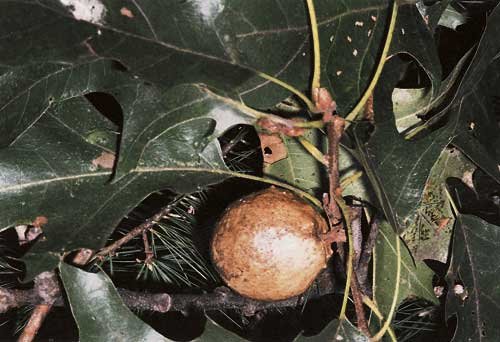Have you ever seen the golf-ball-sized, apple-like objects growing on oak trees? They are caused by a tiny wasp that enlists the help of the mighty oak tree to shelter and care for its offspring. The female wasp, which is wingless, crawls up the trunk of the tree in the spring and goes out on a limb to implant an egg in a tender oak leaf bud. The result is an oak apple gall.
Inside the oak apple gall, the egg hatches into a larva that is protected in a small hard capsule surrounded by spongy tissue. The larva eventually pupates and turns into a winged male or female wasp that chews its way out of the gall, leaving behind a small exit hole.
The winged wasps mate and the female will burrow into the soil to deposit her eggs in the root of the tree. This creates an underground root gall from which only female wingless wasps will emerge. The cycle continues as the wingless wasp crawls up the trunk of the tree and goes out on a limb to implant an egg in a tender leaf bud to form another oak apple gall.
These wasps, which cannot sting, have an unusual life cycle. The generations alternate between being wingless and winged. The wingless wasps are always female.
The oak apple claimed a spot in history when Oak Apple Day was established in England to commemorate the restoration of the English monarchy on May 29, 1660. Although the holiday was formally abolished in 1859, the spirit of the celebration lingers in some parts of England with the wearing of oak leaves or oak apples on May 29, the birthday of King Charles II. According to tradition, anyone not wearing an oak leaf or oak gall on May 29 could face being pinched on the bottom.
At the All Saints Church in Northampton, England, a garland of oak leaves and oak galls is laid at the statue of King Charles II each year on May 29. It is said that the king escaped death as a young prince by hiding in an oak tree. This has earned oak apple galls the name of King Charles Apples.
The great oak tree, a symbol of strength, has become the protective nursery of the delicate oak apple gall wasp. With broad shoulders, the majestic oak is a stately and proud guardian of some of nature’s fascinating creatures.
Paul is a Concord resident who enjoys writing about the outdoor world. Read all of his columns at theconcordinsider.com.









